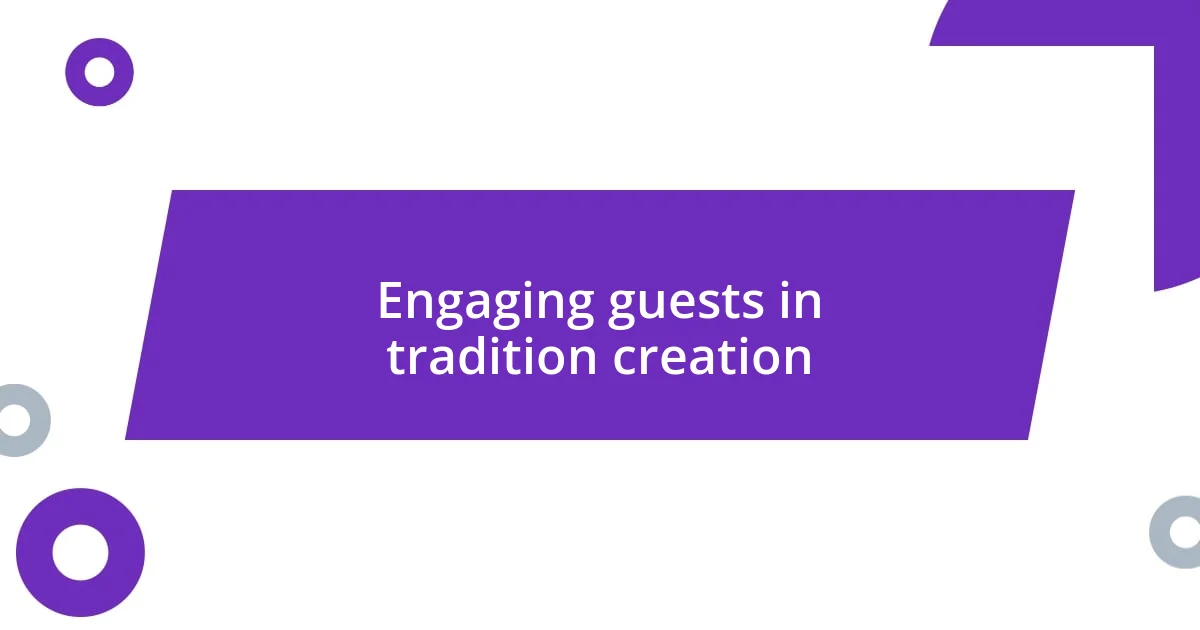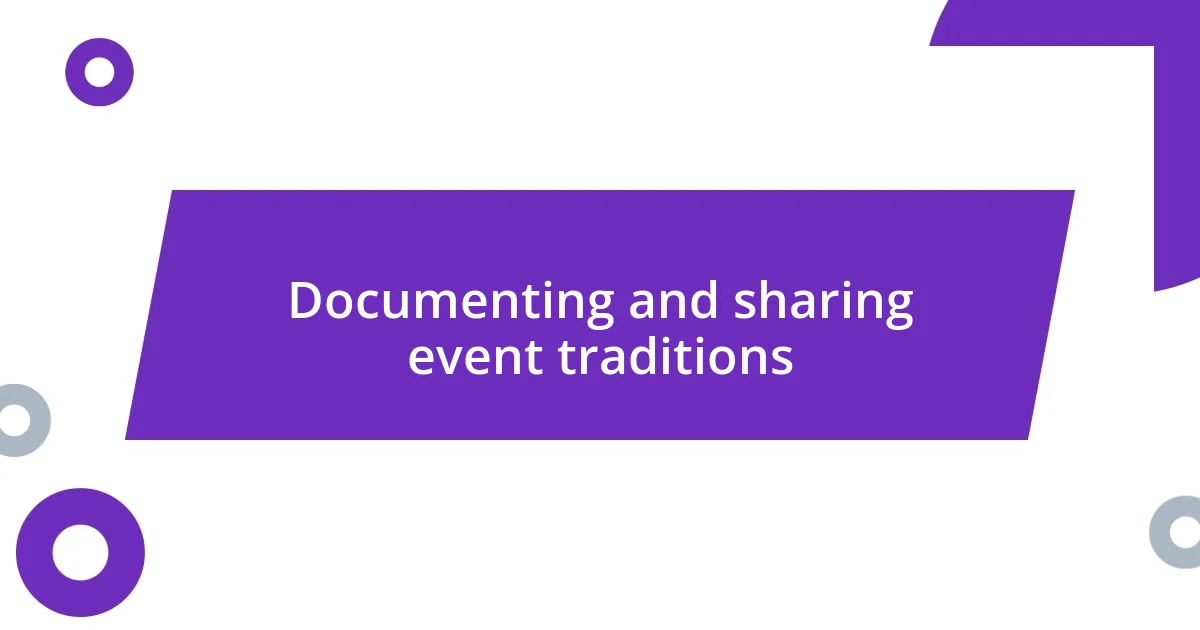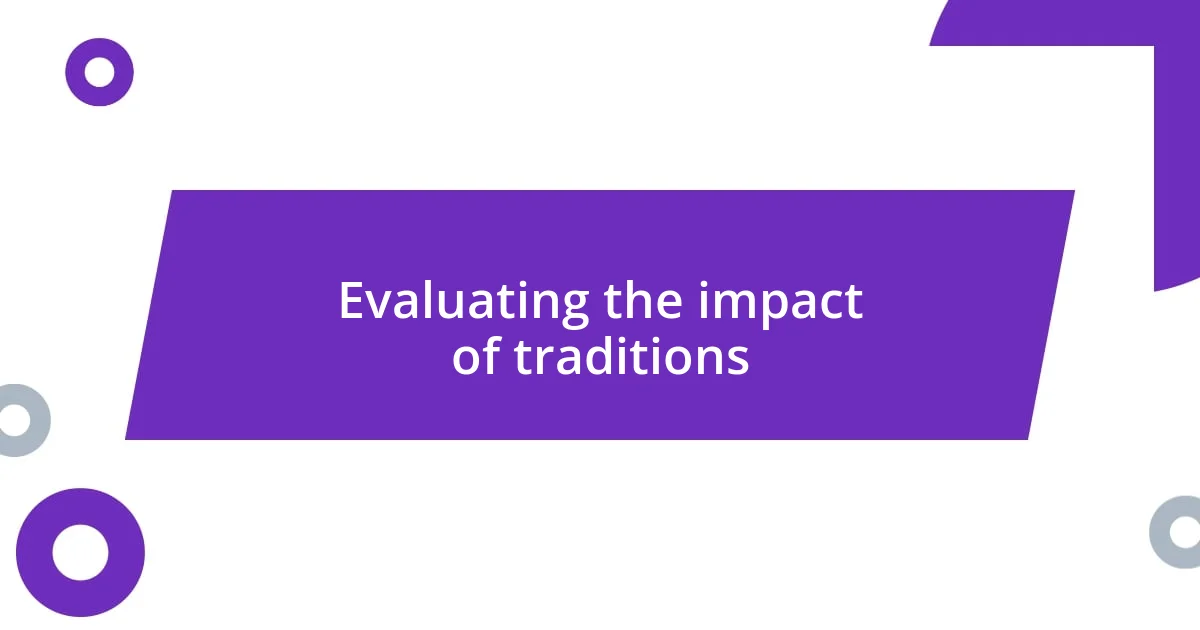Key takeaways:
- Traditions foster connections and evoke a sense of belonging, enhancing the overall experience of gatherings.
- Involving guests in the creation and adaptation of traditions strengthens relationships and ensures relevance over time.
- Documenting and sharing experiences from events can deepen connections and preserve memories for future generations.

Understanding the importance of traditions
Traditions hold a unique power in our lives. I still remember the warmth of my family’s holiday gatherings, where the same stories were told year after year. In those moments, it felt as if time stood still, connecting me to my relatives and their experiences. Isn’t it fascinating how the act of sharing a meal can evoke such a sense of belonging?
When we engage in traditions, we’re not just repeating actions; we’re preserving memories and fostering connections. Take, for instance, the tradition of creating handmade ornaments for our family tree. Each ornament represents a different year, a different chapter of our lives. It’s a joyful exercise in storytelling, reminding us of our shared journey. How does your family commemorate special moments?
Traditions can also provide stability in an ever-changing world. I’ve noticed that during challenging times, leaning into our rituals, like the annual summer BBQ, becomes a source of comfort and reassurance. It not only offers a momentary escape but also reinforces the bonds that we cherish. Doesn’t it bring you peace to know that some things remain constant, no matter what life throws our way?

Identifying key themes for events
Identifying key themes for events is crucial when crafting memorable experiences. I’ve found that the foundation of any successful gathering lies in its thematic coherence. For example, I once organized a community potluck centered around the theme of “Cultural Heritage,” which encouraged attendees to bring dishes that reflected their backgrounds. The result was a vibrant tapestry of flavors and stories that truly united people, going beyond just food. Have you ever considered the impact of a well-chosen theme on your events?
The theme also influences every aspect of event planning, from decorations to activities. During a recent family reunion, we chose the theme “Vintage Summer,” drawing inspiration from nostalgic family photographs. Each detail, from the retro picnic setup to the nostalgic music playlist, helped us reconnect with our shared history. It’s amazing how a clear theme can transform the atmosphere and evoke treasured memories. What themes have you used in your past events that stood out?
Themes provide a roadmap, guiding the planning process and enhancing the overall experience. I often collaborate with friends to plan game nights based on specific themes, like “80s Movies.” Not only do we dress up, but we also create themed snacks. This attention to detail deepens our engagement and creates a playful environment. Have you noticed how themes can elevate even the simplest gatherings into something extraordinary?
| Event Theme | Impact |
|---|---|
| Cultural Heritage | Unites diverse backgrounds, fostering connection through shared stories. |
| Vintage Summer | Reinforces shared histories, evoking nostalgia and deepening relationships. |
| 80s Movies | Enhances engagement with themed activities, creating a playful and immersive environment. |

Engaging guests in tradition creation
When it comes to creating lasting traditions, making guests part of the process is essential. I remember a New Year’s Eve party where we invited everyone to contribute an idea for a new tradition. Each suggestion sparked laughter and excitement. By the end of the night, we had decided on a “Resolution Wall,” where guests could write down their goals for the upcoming year. Not only did it engage everyone, but it also turned each following New Year’s Eve into a reflective experience. Have you ever had a moment like that in your gatherings?
Here’s how you can engage guests in tradition creation:
- Open up discussions: Invite guests to share their favorite traditions and why they matter to them.
- Collaborative activities: Plan hands-on activities where guests can create a keepsake that represents the event, like a group collage or a memory jar.
- Feedback sessions: After an event, gather thoughts on what worked and what didn’t. This way, guests feel invested in shaping future traditions.
- Celebrate contributions: Acknowledge and celebrate the ideas contributed by guests during events by incorporating them into future gatherings.
- Document the journey: Take photos or write a small journal entry capturing the moments and stories shared, creating a lasting memory for everyone involved.
These strategies not only involve your guests but also weave their experiences into the fabric of your events, strengthening connections and enhancing the overall spirit of tradition.

Incorporating personal touches in traditions
Incorporating personal touches into traditions can significantly enrich the experience. For instance, at our annual family holiday gathering, we decided to introduce a “family recipe swap.” Each member brings a dish made from a cherished family recipe and shares the story behind it. This not only allows us to savor beloved flavors but also deepens our connection as we reminisce about our shared history. Have you ever thought about how food connects us in such profound ways?
I recall a time when we added a simple gesture, like having everyone write a short note detailing what the gathering meant to them. We read these notes aloud during dinner. The emotions didn’t just fill the room; they created a tapestry of love and appreciation that brought everyone closer. It’s amazing how such small personal touches can elevate the atmosphere, making the event memorable.
Moreover, customizing decorations with personal elements can be a game-changer. For my friend’s birthday, we used photos from each decade of her life as table centerpieces. Each picture sparked conversations, laughter, and a shared journey down memory lane. When have you seen a simple decoration transform an entire gathering into a tapestry of shared experiences? Personal touches like these not only enhance the visuals but also tie everyone together in a meaningful way.

Documenting and sharing event traditions
Documenting and sharing your event traditions can elevate the experience for everyone involved. I remember hosting a summer barbecue where we created a scrapbook, encouraging guests to bring photos and write down their favorite moments. As we flipped through those pages later, it was heartwarming to see how a simple gathering evolved into a collection of cherished memories. Have you considered how visually capturing your events can foster deeper connections?
In another instance, we used a social media group dedicated to our annual family reunion. Each year, after the event wraps up, we post highlights, stories, and even funny anecdotes that emerge from our time together. It has transformed our gatherings into a digital tapestry that we can revisit and share beyond the event itself. Isn’t it special to have a space where everyone can re-live those precious moments together, long after the day has ended?
Lastly, I’ve found that creating a shared digital photo drive allows everyone to contribute and access photos from the event. It feels inclusive and purposeful. After a holiday gathering, I sent out an email encouraging everyone to upload their snaps, and the following week, we had a beautifully curated visual history of our celebration. It strikes me how this collective effort ignites nostalgia and strengthens bonds—what stories do these shared images tell about your gatherings?

Adapting traditions over time
Adapting traditions over time is crucial to keeping them relevant and meaningful. I remember the first time my friends and I celebrated a milestone birthday. We used to just throw a party, but as life got busier, we realized we wanted those gatherings to feel more significant. So, we introduced a theme that reflected the honoree’s interests each year. That small change not only made planning easier but also added a personal touch that everyone could connect with. Isn’t it amazing how a simple adaptation can breathe new life into something familiar?
Changes in family dynamics also offer an opportunity to reshape traditions. After my grandparents passed, our family was at a crossroads. It was a challenging time, but instead of mourning the loss, we chose to create a new tradition. We started a “Memory Night” where we gather to share stories about our loved ones, complete with their favorite foods and photos. This not only honored their memory but also bonded us in a unique way that felt heartwarming and restorative. Have you ever been faced with change that turned into an unexpected blessing for your traditions?
Culture and technology continuously evolve, influencing how we celebrate together. I found this to be true when my children began inviting their friends to our holiday get-togethers. We adapted our usual activities to include kid-friendly games and themes, ensuring the younger crowd felt included. Watching my children lead their friends in our family traditions filled me with joy and pride. It made me reflect on how crucial it is to remain flexible in our customs. Isn’t it rewarding to see traditions evolve, creating a richer tapestry of experiences for future generations?

Evaluating the impact of traditions
Traditions can profoundly impact our lives, offering a sense of belonging and continuity. I recall the annual camping trip my family took when I was a child. Every summer, we set up tents in the same spot, shared stories around the campfire, and cooked together. Those memories remain a cornerstone of my identity, shaping who I am today. Can you think of a tradition from your past that still resonates with you?
The joy of traditions lies not just in the event itself, but in the feelings they evoke. I will never forget the comfort I felt when my friends and I gathered every winter for a cookie-baking day. Each of us brought our unique recipes and shared laughter as we decorated cookies. It became a ritual that connected us, letting us start the new year with joy and camaraderie. How often do we let ourselves experience such warmth through shared activities?
Evaluating the impact of traditions also has an eye on the future. Reflecting on our family’s Thanksgiving gatherings, I see how they’ve evolved; the focus shifted from simply feasting to emphasizing gratitude. We now spend time sharing what we’re thankful for each year, which deepens our appreciation for one another. Isn’t it fascinating how evaluation can lead to even richer experiences? By nurturing these practices, we ensure they continue to resonate through generations.














